(Left to right): Former Demon Lucas Cook, recently delisted Jake Patmore, former Crow and later Blue Laurence Angwin.
They are the “runt of the litter”. The ones – despite all the hype from the scouting notes – who do not make it with the rest of the newbies drafted to Australian football’s elite league.
Every AFL club has them – at least one draftee each year who does not make it to the big time and is delisted or traded to try his luck elsewhere.
Some teams have had more misses in the various drafts than others, surprisingly bringing into question more often the club’s recruiting staff rather than the development programs that are supposed to put the finishing touches on a would-be AFL star.
The example of how a highly-touted teenage prospect can sit on a team list for years but not ever play an AFL game was highlighted during the recent delistings leading up to the national draft on December 7.
Jake Patmore joined Port Adelaide with selection No. 58 in the 2017 AFL national draft. He came from WAFL club Claremont, with Port Adelaide recruiting manager Geoff Parker – who has made standout calls to revitalise Ken Hinkley’s squad at Alberton – oozing in his vision of promise to unfold in the West Australian teenager.
“He’s been a prolific ball winner and has showed a lot of smarts to get through traffic and use the ball to advantage,” Parker said at the end of the 2017 draft.
Indeed, while playing every SANFL game in 2018, Patmore appeared a good pick for a Port Adelaide squad preparing to change direction by heavily backing youth.
Certainly, Hinkley does not fear playing new draftees early, as highlighted by his immediate faith in 2018 first-round draftees Connor Rozee, Zak Butters and Xavier Duursma for so many games last year and again in 2020.
But disaster struck on a Friday night in the 2019 pre-season, Patmore suffering a season-ending knee injury in an SANFL trial against South Adelaide. And 2020 presented no chance to play in a state league in which he could prove his worth as an AFL prospect at Port Adelaide.
Every year at every club it happens … one draftee becomes the “runt who didn’t make it”. This is despite all the greater attention AFL clubs have put into assessing potential draftees, not just by their football talent but their character, family backgrounds and those infamously weird psyche-testing questions.
Next month’s AFL national draft calls are to become even more speculative considering the loss of football competitions for many teenagers as a result of the shutdowns from the COVID pandemic, in particular in Victoria – the largest cradle of teenage draft prospects.
Former Melbourne captain Garry Lyon in 2014 noted the men and women charged with recruiting decisions are “just about the most-important people in a football club”.
“Get (recruiting decisions) wrong and they (recruiters and list managers) can subject their football club to the type of long-term misery that can only lead to disastrous ramifications,” Lyon wrote.
“I suspect most (recruiters) prefer to fly under the radar. But in an era where accountability in football is expected and demanded, these men should be assessed, applauded, rewarded or criticised according to their success or failure.
“We should be able to put a face to the name of the men who play such a pivotal role in the fortunes of the club we love and commit to each year.”
Since then – and until COVID hit football spending budgets – AFL invested heavily in technology and staff to rate talent.
But for all the noted advancement in scouting potential AFL draftees and beefing up of recruiting departments and development programs at AFL clubs, there are still those who never make it – not even for a sampler in the big league.
Player agent Ben Williams notes there are so many unexpected turns that can make or break an AFL player.
“A bit of luck comes into it,” Williams said. “You can see a player picked up late in the draft and he goes to a really strong club such as Richmond and Geelong, clubs that tend not to be in the business of developing players for the longer term. Their premiership window is finite, so they are dealing with the here and now.
“The players taken earlier in the draft have a lot of resources and energy put into them, particularly those in the first handful of picks – they traditionally go the lesser-performed clubs of the previous year so they will get more opportunities (to play an AFL games).”
There also is, as noted with Patmore, injury. And some draftees do not cope with moving from home.
PLEASE HELP US CONTINUE TO THRIVE BY BECOMING AN OFFICIAL FOOTYOLOGY PATRON. JUST CLICK THIS LINK.
The most notorious moment of draft failure is Adelaide in 2000. The story reads as follows:
Pick No.7 – Laurence Angwin. No AFL game for the Crows before moving to Carlton. He was chosen on the urging of then Adelaide coach Gary Ayres, against the wishes of recruiting manager James Fantasia.
Pick No. 38 – Michael Handby. No AFL game for the Crows. The debate within the Adelaide camp had turned away from Adam McPhee, who went at pick No.39 to Fremantle, where he had two stints (2001-2002 and 2010-2012) while playing 142 AFL games with Essendon, where he was the club champion and an All-Australian in 2004.
Pick No. 48 – Matthew Smith. No AFL game for the Crows. Three donuts on the club’s first three picks.
Pick No.53 was used to claim local boy Hayden Skipworth, who played 44 AFL games in six seasons before finding a second chapter at Essendon.
Adelaide’s last pick at No.67 was defender Graham Johncock – 227 matches from 2001-2013, club chairman Rob Chapman once famously declaring the Port Lincoln recruit a fancy as a Brownlow Medallist.
“We did redeem ourselves somewhat at the back end of that draft,” says Fantasia today.
But the misfires with Angwin, Handby and Smith did prompt an extraordinary paper from the recruiting division to the Adelaide board to set up strict procedures to avert a repeat of the Angwin disaster – and the mistake in overlooking McPhee after the recruiting notes from club servant Phil Harper identified the Victorian teenager as an ideal draftee.
The theme of setting strict drafting procedures has followed to other AFL clubs with list managers and recruiting chiefs deciding on draft strategies rather than coaches, who under pressure for immediate wins could have short-term wishes to protect their jobs rather than the long-term interests of the club.
But since 2010 – with the expansion of the national league to 17 teams with Gold Coast and then 18 with Greater Western Sydney a year later – there have been draft misfires everywhere.
The most costly in terms of a high-order draft pick being burned? Melbourne in 2010 with its first pick at No. 12 – Victorian country recruit Lucas Cook.
A tall forward from Hopetoun, Cook impressed in his first NAB Cup pre-season game, but never made it and was delisted after the 2012 season at the end of his introductory two-year AFL contract.
He was not traded, nor did he find his luck change with a second chance at another AFL club. He stayed in Melbourne to play VFL football with Port Melbourne until returning to the Southern Mallee last year.
Collingwood drafted midfielder Nathan Freeman with pick No.10 in the 2013 AFL national draft. Recurrent injuries denied the Sandringham recruit an AFL game with the Magpies before he was traded to St Kilda at the end of the 2015 season. He had three years with the Saints – and just two AFL games in 2018.
The surprising note from the review of every AFL club’s bidding in the drafts since 2010 is Geelong, a club noted for being very sound in its recruiting under the long-time direction of Stephen Wells.
Having a stable first-team line-up while establishing the league’s most-consistent winning record in home-and-away football certainly would make it tough for a late-pick draftee to crack an AFL game at Kardinia Park.
Since 2010, Geelong has called without a return in AFL games …
No.32 (2011): Danish-born Joel Hamling. He had three years at the Cattery before moving to the Western Bulldogs – as a delisted free agent – at the end of 2014. He became a premiership player in his two seasons at the Dogs before joining Fremantle after the 2016 AFL grand final.
No.36 (2013): West Australian Jarrad Jansen, who had two seasons at Geelong before the strong-bodied midfielder was traded to Brisbane. He chased his dream for two seasons with the Lions, with whom he played eight AFL games before being delisted at the end of 2017.
No.55 (2014): South Australian Dean Gore, who after less than 12 months at the Cattery was added to the deal that allowed Patrick Dangerfield to leave Adelaide at the end of the 2015 season. Despite all the promise, Gore never made it with the Crows and flip-flopped between VFL football at Geelong and SANFL duty at his home club at Sturt.
No.59 (2015): Ryan Gardner. Three years with no AFL game at Geelong before the Taswegian was claimed by the Western Bulldogs in last year’s mid-season rookie draft. He managed 10 senior games in 2020, for 12 in two seasons with the Dogs.
No.70 (2015): Matthew Hayball. Delisted without an AFL game after two years at Geelong. From Australian football, the Port Pirie-born Hayball this year made it to American college football at Florida Atlantic University.
No.68 (2016): Timm House. The tall West Australian swingman went from Geelong to VFL club Werribee last year – after spending time on the family farm at Gnowangerup – with no AFL game on his record.
No.50 (2018): Jacob Kennerley. The South Australian was delisted this year.
There are seven draftees since 2018 still at Kardinia Park waiting for their AFL debut with Geelong – Jake Tarca (No.68, 2018); Oscar Brownless (No.74, 2018); Nathan Kreuger (supplementary, 2018); Cooper Stephens (No.18, 2019); Sam DeKonning (No.19, 2019); Francis Evans (No.41, 2019); Cameron Taheny (No.50, 2019).
Greater Western Sydney has shown the most patience in recent times with a draftee. The Giants added ruckman Matthew Flynn to its academy in 2009 when he was 12. They introduced him to their AFL roster with the No.41 in the 2015 national draft. His progress was halted in July last year with an ACL injury that led to surgery for a knee reconstruction.
It is not surprising that Gold Coast has played all but two of its draftees since entering the AFL player lottery in 2010. Those two are 2018-19 supplementary pick Sam Fletcher and 2019 mid-season draftee Mitch Riordan.
In 2004, when writing for “The Age”, Footyology chief Rohan Connolly noted: “If AFL recruiting is a science, it is at best pretty inexact. And you only have to glance at the catalogue of misses among the biggest hits out of all the drafting and trading over the years to realise just how inexact.”
Almost two decades later the catalogue continues to expand.
Club by club, here are the misses, players since 2010 to have played no senior AFL games with the team which drafted them.
ADELAIDE: Nick Joyce (No.46, 2011); Sam Siggins (No.62, 2012); Harrison Wigg (No.35, 2014); Harry Dear (No.58, 2014); Matt Signorello (No.62, 2016).
BRISBANE: Patrick Wearden (No.47, 2011); Josh Watts (No.65, 2014); Corey Lyons (No.71, 2016); Toby Woller (No.41, 2017).
CARLTON: Cameron Giles (No.39, 2013); Jayden Foster (No.63, 2014); Finbar O’Dwyer (No.66, 2018); Ben Silvagni (No.70, 2018).
COLLINGWOOD: Daniel Farmer (No.46, 2010); Trent Stubbs (No.77, 2010); Nathan Freeman (No.10, 2013); Sam McLarty (No.30, 2013).
ESSENDON: Luke Davis (No.64, 2010); Sean Gregory (No.88, 2012); Alex Morgan (No.29, 2015); Yestin Eades (No.64, 2015); Jordan Houlahan (No.49, 2017); Noah Gown (No.60, 2018).
FREMANTLE: Tom North (No.65, 2017); Dillon O’Reilly (No.11, 2019 mid-season).
GEELONG: Joel Hamling (No.32, 2011); Jarrad Jansen (No.36, 2013); Dean Gore (No.55, 2014); Ryan Gardner (No.59, 2015); Matthew Hayball (No.70, 2015); Timm House (No.68, 2016); Jacob Kennerley (No.50, 2018).
GOLD COAST: Sam Fletcher (supplementary, 2018-19); Mitch Riordan (mid-season, 2019).
GREATER WESTERN SYDNEY: Jarrod Pickett (No.4, 2014); Paul Ahern (No.7, 2014); Pat McKenna (No.23, 2014); Lachie Tiziani (No.54, 2016); Kieran Briggs (No.34, 2018).
HAWTHORN: Jordan Kelly (No.38, 2011); Dayle Garlett (No.38, 2013); Zac Webster (rookie elevation, 2014).
MELBOURNE: Lucas Cook (No.12, 2010); Rory Taggert (No.36, 2011); Mitch King (No.42, 2015); Liam Hulett (No.46, 2015); Dion Johnstone (No.64, 2016); Aaron Nietschke (No.53, 2018).
NORTH MELBOURNE: Ben Mabon (No.71, 2010); Tom Curran (No.40, 2011); Mitch Wilkins (No.47, 2012); Declan Watson (No.34, 2016); Joel Crocker (No.69, 2018).
PORT ADELAIDE: Mason Shaw (No.30, 2012); Mitch Harvey (No.45, 2013); Jake Patmore (No.58, 2017); Riley Grundy (No.73, 2018).
RICHMOND: Dean McDonald (No.51, 2010); Reece McKenzie (No.77, 2014); Luke English (No.62, 2018).
ST KILDA: Sam Crocker (No.43, 2010); Daniel Markworth (No.35, 2011); Jay Lever (No.60, 2011); Jack Mayo (mid-season No.8, 2019).
SYDNEY: Jordan Lockyer (No.43, 2010); Alex Brown (No.61, 2011); Nathan Gordon (No.85, 2010); Matthew Dick (No.64, 2012); Abe Davis (No.70, 2014); Tyrone Leonardis (No.51, 2015); Cody Hirst (mid-season No.16, 2019).
WEST COAST: Brad Dick (No.79, rookie elevation 2012); Dylan Main (No.49, 2013); Damien Cavka (No.66, 2014); Alec Waterman (No.76, 2014); Matthew Allen (No.62, 2015); Keegan Brooksby (supplementary 2018-2019).
WESTERN BULLDOGS: Tom Hill (No.89, 2010); Matthew Panos (No.73 rookie elevation, 2011); Declan Hamilton (No.39, 2014).

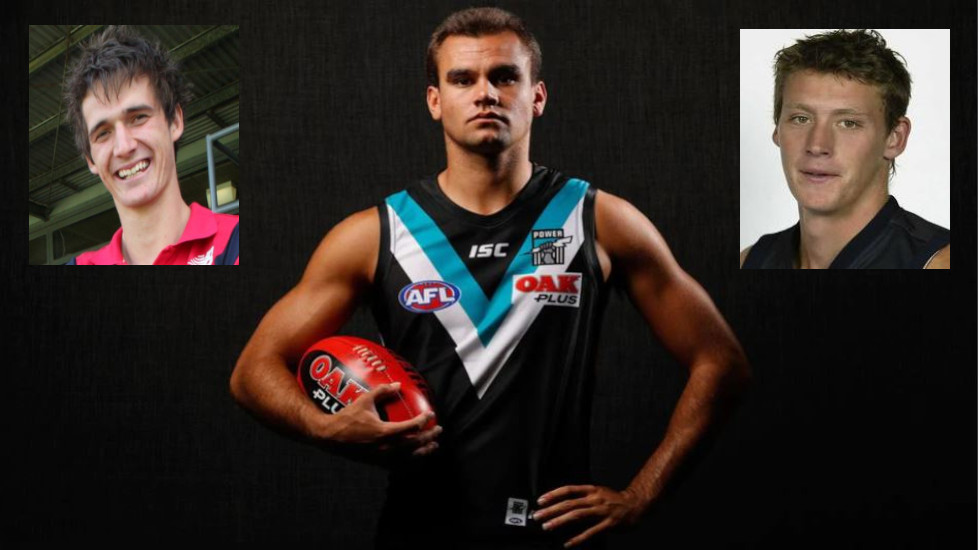
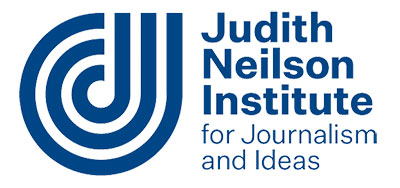
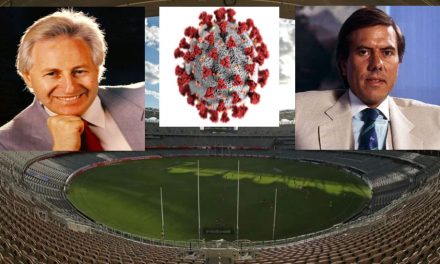
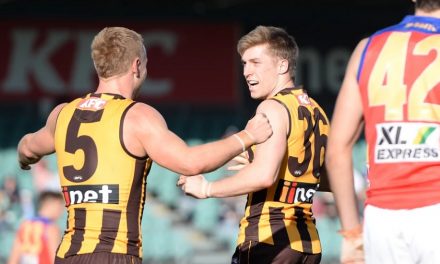
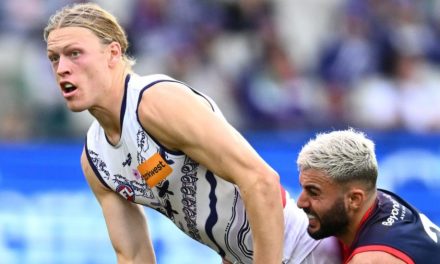
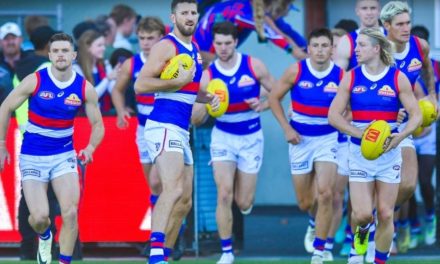






you forgot Dillon Viojo Rainbow for Carlton